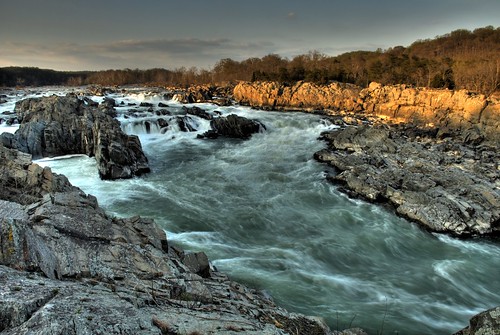
For spectacular scenery within an easy drive of Washington, DC, it's hard to beat Great Falls. The wide, flat Potomac River drops 76 feet over the course of a mile, culminating in a series of rapids and 20-foot waterfalls that you can view from overlooks on either side of the river. The river then enters deep, narrow Mather Gorge, with rocky cliffs on both sides. This is about as dramatic as it gets around here.
 The Maryland side
The Maryland side, which is managed as part of the C&O Canal, is the side we usually go to -- mostly because it's easier to get there from where we live. From the C&O Canal towpath, you'll walk along a boardwalk, across a bridge that crosses some rapids that are impressive in their own right, then along a boardwalk over Olmstead Island to a view of the falls.
Away from the falls, you can walk for miles along the canal, as well as along several more challenging, rocky trails along the river. (See the
park map and
trails description.) We'll often stop by the falls, then hike the Billy Goat A trail and come back on the canal, which is a loop of about 4 miles (see
this description). April through October, you can
ride on a boat in the canal as it goes through the locks of the canal. Uphill from the canal, there are trails through the woods to an old gold mine -- it's not much to look at, but
has an interesting history.
 The Virginia side
The Virginia side, which is managed as part of the GW Parkway, is the more heavily visited side. The park offers three overlooks of the falls here, and they involve a shorter walk than on the Maryland side -- one is just a 2 minute walk from the visitor center.
Beyond the overlooks, you'll find miles of hiking on this side of the river as well. (See the
park map.) To the north, you can walk to Riverbend Park; to the south, you can catch the Difficult Run Trail, which follows that river for 15 miles through Fairfax County. See this
description of a 5-mile hike that combines a stretch of Difficult Run, the path along the Potomac as it passes through Mather Gorge, the overlooks of the falls, and a return through the middle of the park on the Swamp Trail.
 Entrance fee:
Entrance fee: $5/car on either side. Your receipt is good for 3 days and will get you in to both parks. Folks often park outside the parks and hike in. On the Maryland side, it's a little over 2 miles from Angler's Inn to the falls. On the Virginia side, you can park where Difficult Run crosses Georgetown Pike, also a little over 2 miles from the falls. But why not give $5 to your National Parks? They could use the cash.
 Dogs:
Dogs: In Maryland, dogs are
not allowed on the trail to the falls on the Maryland side or the Billy Goat A trail, but are allowed on the canal and other hiking trails.
In Virginia, dogs are allowed throughout the park
. In both parks, dogs must be on leash. And please scoop their poop, to avoid polluting the water.
Bikes: In Maryland, bikes aren't allowed on any of the hiking paths. But you can ride to your heart's content on the C&O Canal -- you'll just need tires that can take the rough path. In Virginia, five miles of trails are open to bikes: the Old Carriage Road, Ridge, and Difficult Run trails. Biking is not permitted on the River, Patowmack Canal, Mine Run, or Matildaville Trails.
Climbing: The cliffs along the river are a popular rock climbing destination.
This site has descriptions of the routes on the Virginia side.
 Kayaking:
Kayaking: Not for the faint of heart, or inexperienced kayakers -- this is serious whitewater.
These sites have descriptions of the rapids and their difficulty.
Swimming is prohibited. Several people have died swimming in this section of the Potomac.
Fishing is allowed, with the appropriate state license.
Do you have a favorite spot or trail at Great Falls, or a story to tell? Leave us a comment!
Like the photos in this post? Mouse over for credits; a click takes you to the photographer on Flickr.



















































